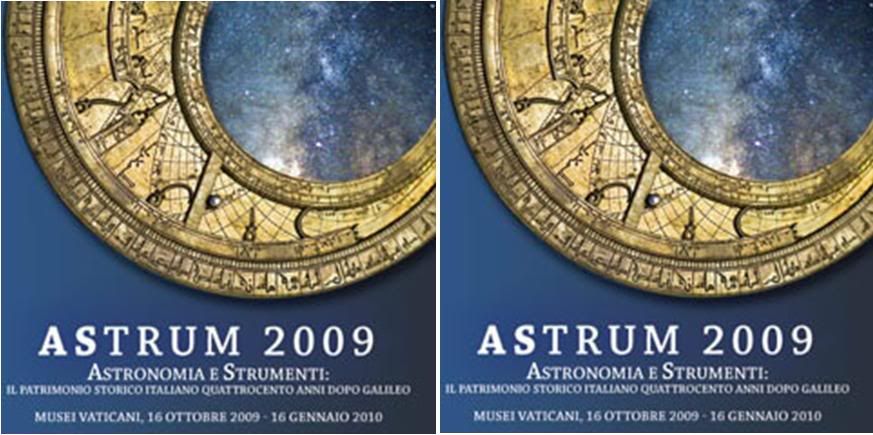 Vatican celebrates
Vatican celebrates
the history of astronomy


VATICAN, Oct. 13 (AP) -- Rudimentary telescopes, celestial globes and original manuscripts by Galileo are going on view at the Vatican Museums as part of an exhibit marking the 400th anniversary of the astronomer's first celestial observations.

"Astrum 2009: Astronomy and Instruments" traces the history of astronomy through its tools, from a 3rd century A.D. globe of the zodiac to the increasingly complicated telescopes used in more recent times to gaze at the stars. The exhibit opens Friday and runs through Jan. 16.
At a briefing to launch the exhibit Tuesday, Monsignor Gianfranco Ravasi, the Vatican's top culture official, declined to revisit the Church's 17th century condemnation of Galileo for his discovery that the Earth revolved around the sun.
Church teaching at the time placed the Earth at the center of the universe.
Rather, Ravasi said that, while it was necessary to have the courage to admit errors when they were made, "I continue to believe that it's necessary to look more to the future."
The church denounced Galileo's theory as dangerous to the faith. Tried as a heretic in 1633 and forced to recant, he was sentenced to life imprisonment, later changed to house arrest.
The ruling helped fuel accusations that the Church was hostile to science -- a reputation the Vatican has been trying to shed ever since.
In 1992, Pope John Paul II declared that the ruling against Galileo was an error resulting from "tragic mutual incomprehension."
The exhibit, and other Vatican initiatives to mark the 400th anniversary of Galileo's telescope and the U.N.-designated International Year of Astronomy, is part of the Vatican's continuing rehabilitation effort.
One of the highlights of the show is Galileo's original manuscript of "Sidereus Nuncius," the 1610 document in which he excitedly recorded his first discoveries after using his telescope.
Tommaso Maccacaro, president of Italy's National Institute of Astrophysics, said it was important to look at the instruments not just from a scientific view but from a cultural one as well, since astronomy has had such an impact on the way we perceive ourselves.
"It was astronomical observations that let us understand that Earth (and man) don't have a privileged position or role in the universe," he said in his prepared comments to the briefing. "I ask myself what tools will we use in the next 400 years, and I ask what revolutions of understanding they'll bring about, like resolving the mystery of our apparent cosmic solitude."
 History of Italy's celestial studies
History of Italy's celestial studies
stars in Vatican Museums' exhibit
By Carol Glatz

VATICAN CITY, oCT. 13 (CNS) -- The Vatican and Italian observatories have teamed up to display for the first time numerous precious instruments and books documenting the birth and development of stargazing in Italy.
The Vatican Observatory, the Italian National Institute of Astrophysics and the Vatican Museums have pooled their collections of antique telescopes, astrolabes, celestial globes and manuscripts, such as Galileo Galilei's original handwritten notes detailing his observations of the moon. Many of the 130 items in the exhibit have never been displayed publicly.
The exhibit, called "Astrum 2009," runs at the Vatican Museums from Oct. 16 to Jan. 16, 2010, and commemorates the International Year of Astronomy.
The United Nations declared the special year to mark the 400th anniversary of Galileo's first use of the telescope to observe the cosmos.
The exhibit's curator, Ileana Chinnici, told journalists during a Vatican press conference Oct. 13 that Italy's unique patrimony of astronomical instruments is the richest in the world.
Popes and the divided Italian states all supported their own observatories and amassed a large number of historical instruments and valuable documentation, she said.
Some of the unique and valuable objects on display include Galileo's handwritten notes and his publication "Starry Messenger" from 1610, both of which detailed how he perfected the telescope to magnify distant objects 30 times the size they appear to the naked eye.
There is also a replica of one of Galileo's telescopes created by Massachusetts-based craftspeople Jim and Rhonda Morris. The original is in the Institute and Museum of the History of Science in Florence, Italy.
Also on display is the arithmometer, one of the first commercial calculating machines. Created in 1882, it helped scientists do complex additions, subtractions, multiplications and divisions as well as extract square roots.
A few sections of the 130-piece exhibit are dedicated to the Vatican's history of astronomical research, including its participation in the 19th-century international "Carte du Ciel" (Map of Heaven) project to catalog and make a map of the stars.
Between 1910 and 1921, the Vatican Observatory assigned three nuns to help with the map project. These Sisters of the Child Mary measured the coordinates of tens of thousands of stars reproduced on photographic glass plates.
Also on display for the first time are photographs of a papal expedition to Russia in 1887 to witness and document a total solar eclipse. Three Italian priests made the trip, which proved unsuccessful due to poor weather and viewing conditions.
Missing from the exhibit is any mention of the church's troubled history and dealings with Galileo.
The Italian scientist was condemned for suspected heresy in 1633 for maintaining that the earth revolved around the sun. He was "rehabilitated" in 1992 by a special Vatican commission established by Pope John Paul II.
The church has made significant overtures in recent decades to show that faith and science do not conflict.
Galileo opened up a brand new way of doing science, which wasn't accepted immediately, said Cardinal Giovanni Lajolo, president of the commission governing Vatican City in a written introduction to the exhibit's catalog.
These groundbreaking scientific discoveries help people better understand God's creation, he wrote, and the exhibit shows how science "is an inescapable part" of the human spirit and the whole human experience.

[Modificato da TERESA BENEDETTA 14/10/2009 02:09]